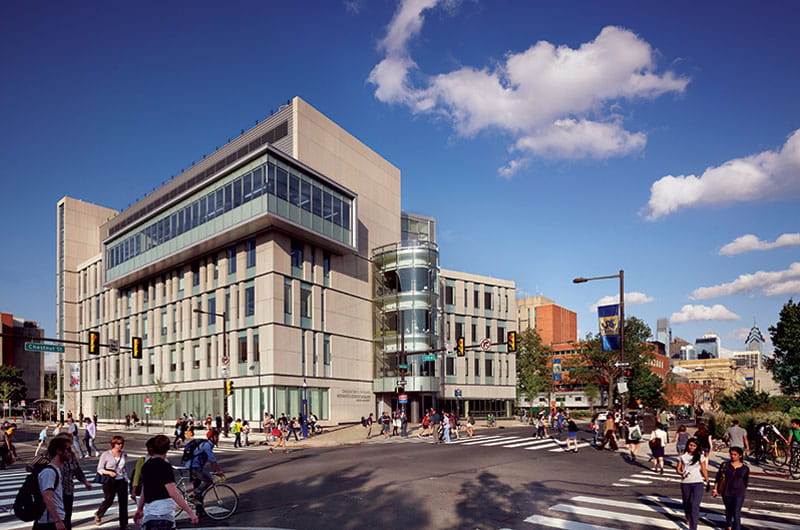Drexel Joins Regional Effort to Reduce Carbon Emissions by Making Buildings More Energy-Efficient

Drexel is one of the first institutions in the region to join the Delaware Valley Green Building Council's Philadelphia 2030 District initiative to reduce carbon emissions.
Through its Institute for Energy and the Environment and breadth of research in environmental science and engineering, Drexel University has a longstanding commitment to sustainability and environmental preservation. The University recently reaffirmed this commitment by joining a regional partnership of property owners, utilities and energy service companies, and community organizations in Philadelphia that have pledged to help reduce energy and water use and transportation emissions by 50 percent by the year 2030.
The “Philadelphia 2030 District” initiative, which was announced by the Delaware Valley Green Building Council on Oct. 26, adds the city to a group of 17 others that have made similar pledges around the country in hopes of slowing the nation’s contribution to climate change.
“As Philadelphians, we recognize that our city is world class, and we are committed to implementing sustainable building practices that will provide a better quality of life for all of our citizens,” Mayor Jim Kenney said at the event announcing the program. “The launch of the Philadelphia 2030 District strongly aligns with the city’s Greenworks initiative and will encourage the community to mitigate our impact on climate change, while allowing Philadelphia to serve as a national example of the importance of reducing a city’s environmental impact.”
According to the Green Building Council, in Philadelphia, 60 percent of the carbon emissions that cause climate change are produced by the building sector, and an average building wastes 30 percent of its energy. By making an investment in Philadelphia’s 2030 District, the city will work to improve its built environment while creating an opportunity to reduce the region’s climate impact.
“Though the built environment is the largest single contributor to greenhouse gas emissions in the U.S., contributing almost 50 percent, many people, understandably, aren’t aware that buildings have multiple sources of greenhouse gas emissions,” said Hugh Johnson, senior associate at the Institute for Energy and the Environment. “There are the emissions associated with the electricity purchased to power our electronics, keep the lights on and run the air conditioning. The second major source of a building's emissions is the onsite combustion of primarily natural gas to produce heat and hot water. This can not only be a significant source of emissions for a given building, but it also contributes to local air pollution and the associated public health problems.”
At Drexel, participating in the initiative means gathering data on water consumption, building energy use, greenhouse gas emissions from shuttle busses and making adjustments to continue on a course that would meet the 2030 District goals, according to Christopher Plummer, executive director of University Facilities. In addition to pursuing the highest levels of energy efficiency certification for all of its renovations and new construction, the University is adding monitoring technology that will allow it to gather data and focus on energy-saving procedures in each building. It is also looking at adding alternative-energy-powered shuttles to its fleet.
One conservation effort that is already seeing excellent returns is the addition of weather and moisture sensors to the irrigation system at Drexel Park. Plummer said the sensors resulted in a 51 percent reduction in water use and because of their success the University plans to install the sensors as part of the quad’s renovations and as a retrofit to other systems across campus.
Drexel’s Institute for Energy and the Environment has already played an important role in the city’s greenhouse gas reduction efforts, producing a report in 2015 on how Philadelphia could reduce emissions by 80 percent by the year 2050. Data from that report has guided many of the mayor’s initiatives since then and will make reaching the Philadelphia 2030 District goal eminently attainable.
Drexel joins commerce and transportation leaders including Brandywine Realty Trust and SEPTA as early participants in the 2030 District initiative. As part of the program, participating property owners and managers gain access to a network of peers to share strategies and best practices, as well as tools and resources to help improve and add value to their assets.
“Now more than ever, it’s important for cities to join the national initiative to create healthier, more sustainable buildings,” said Alex Dews, executive director of Delaware Valley Green Building Council. “The 2030 District will do just this by introducing more efficient and sustainable building practices into the Greater Philadelphia region while focusing on both energy and water conservation. We believe the launch of this initiative will encourage local leadership to reevaluate their impact on climate change and take the necessary steps to make a measurable difference.”
To learn more about the Philadelphia 2030 District, visit: http://www.2030districts.org/philadelphia
Drexel News is produced by
University Marketing and Communications.
